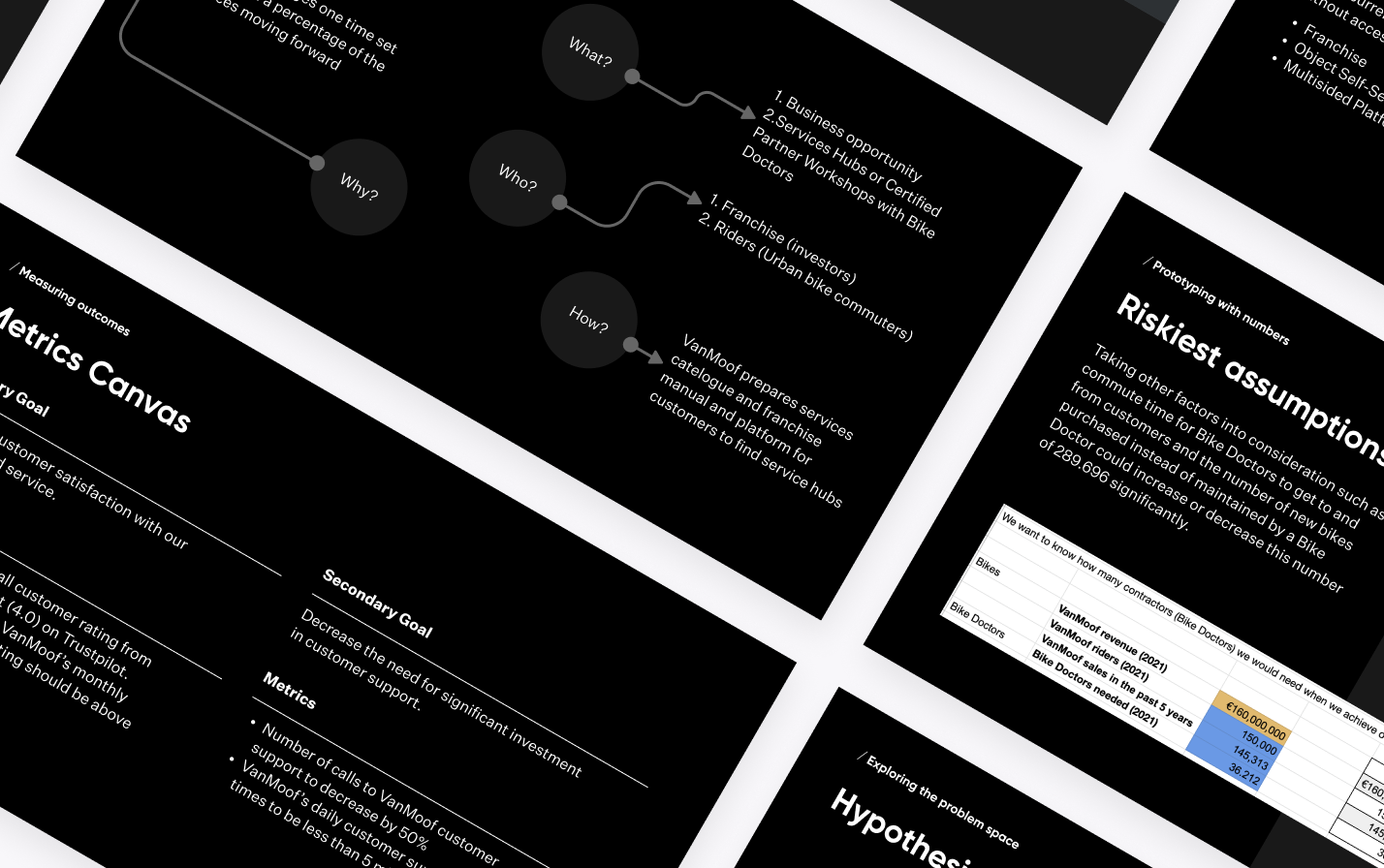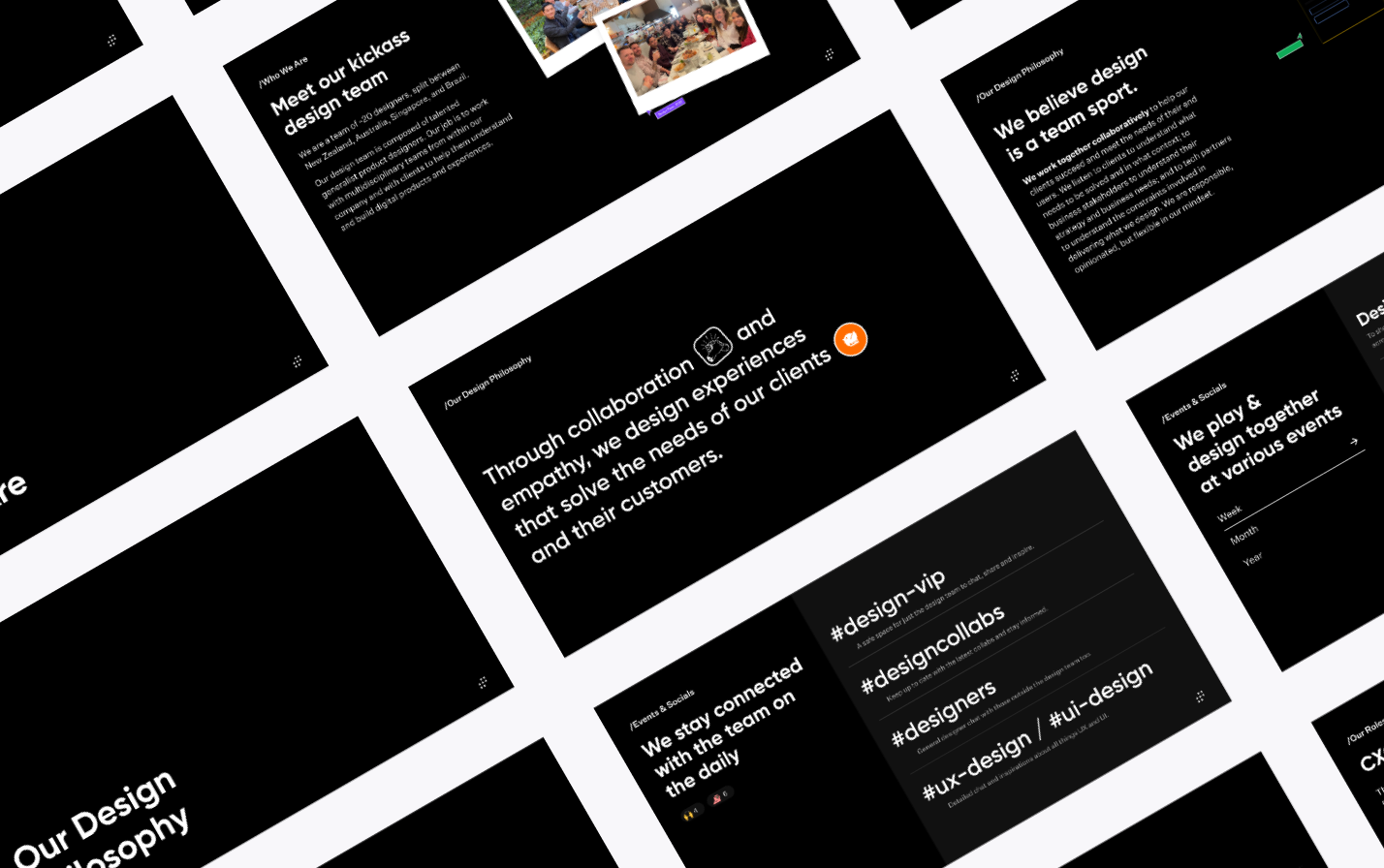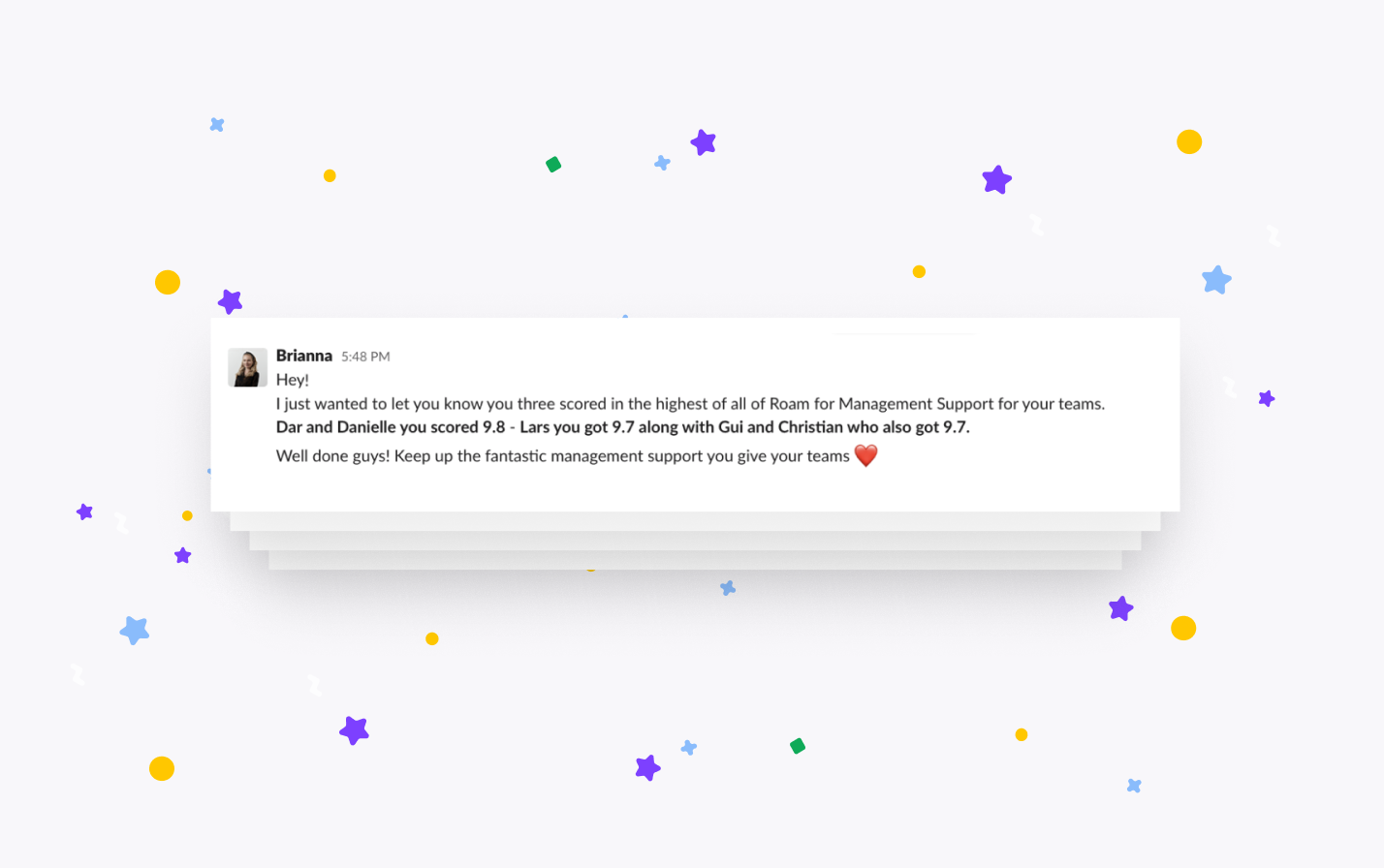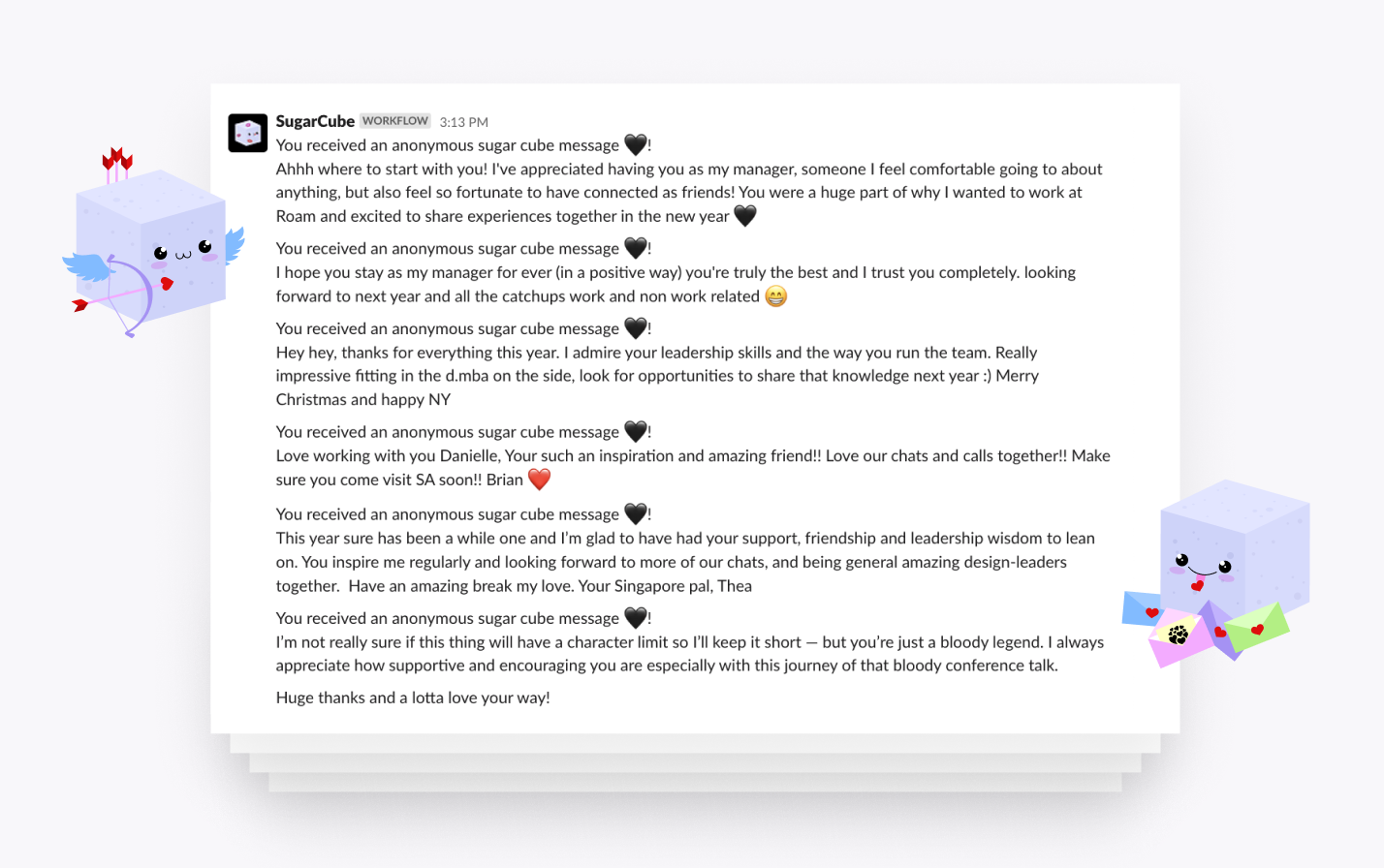/ Career Highlights
Designing for Impact.
Senior Experience Design Director • Stellar Elements
As a Design Manager, my main priority is to enable and empower my team. Although the results of this work may not be as easily quantifiable as those of project work, I strongly believe in the value of fostering a collaborative and supportive environment where designers can produce their best work.
Here are some recent career highlights that demonstrate:
Nurturing an environment where designers can craft their best work
Bringing curiosity, new perspectives, and innovative ideas
Teaching designers the skills to achieve excellence in their craft
Approaching new working relationships with empathy and humility
/ Example 1
New Service Offering:
Empowering Strategic Design
Motivation behind the initiative
The d.MBA program was transformative for me, enhancing my business acumen and boosting my confidence to engage in conversations around value creation. This program provided me with new tools and techniques to create more opportunities for clients and end users. Consequently, I took the initiative to introduce a new service offering to create a new value stream and upskill the design team in business strategy.
Implementation Strategy
Amidst current economic challenges, I identified an opportunity to leverage my new knowledge and proposed a new design phase that enables us to rapidly evaluate a business by testing the riskiest assumptions and validating the viability of their options moving forward. The Opportunity Sprint created a new revenue stream and empowered designers to build their strategic acumen, become more fluent in the universal language of business, and be better equipped to drive conversations with clients.
/ Example 2
Enhancing Designer Onboarding:
Setting Up for Success
Motivation behind the initiative
To cultivate a culture of happy and engaged designers, it is essential to start by setting them up for success from day one. Establishing a strong sense of belonging during onboarding helps designers feel connected, sparking excitement and motivation to deliver exceptional results. Consequently, I took the initiative to improve our designers' onboarding experience, aiming to boost employee engagement from the beginning and reduce attrition.
Implementation strategy
Drawing inspiration from renowned design leaders across the industry, I took it upon myself to reimagine our onboarding journey. Moving away from lengthy and tedious Confluence pages, I crafted an interactive prototype meticulously designed to achieve more than just a basic introduction. It was crafted to cultivate a sense of value and empowerment from day one. This revamped onboarding experience sets the tone for the first year and lays the groundwork for designers to produce valuable outputs in an environment primed for success.
“The onboarding experience has been pretty awesome. I really like the ideas around your first few days, weeks, months around what to read and what is important and the best content to digest over time.”
/ Example 3
Fostering Psychological Safety:
Empowering Creativity in Designers
Motivation behind the initiative
In today's remote and hybrid working environments, cultivating a sense of community and trust among team members is more challenging than ever. I delved into the insights of thought leaders such as Daniel Coyle, Simon Sinek, and Adam Grant and came to appreciate the significance of psychological safety in fostering high-performing teams. Their work emphasises the vital role of meaningful human connections in enabling team members to freely share ideas, acknowledge mistakes, and take risks without fear, ultimately leading to more innovative and impactful design work. Inspired by these principles, I took the initiative to explore how I could integrate this concept within our design team.
Implementation strategy
Design Team Trading Cards
To facilitate connection and expression of individuality within the team, I introduced the Design Team Trading Cards activity. This interactive exercise encouraged each team member to create and share their own trading card, highlighting their unique strengths, interests beyond design, and preferred modes of collaboration and communication. By providing a platform for self-expression, we accelerated the process of relationship-building and nurtured a deeper sense of belonging in an engaging and enjoyable manner.
Mid Morning Design Matters
To build on this I established the design team weekly meeting, Mid Morning Design Matters. This session provides a dedicated space for designers to lead meaningful discussions, explore new ideas, engage in collective learning, and strengthen bonds. It has quickly become a cherished part of our culture.
Due to its success, Mid Morning Design Matters was expanded to our studios in New Zealand and Singapore, further amplifying its impact across the business.
/ Example 4
Empowering Designers to Excel:
Cultivating Good Practice and Craftsmanship
Motivation behind the initiative
To maximise a team's productivity, it's important to have skilled and capable contributors. This goes beyond merely equipping designers with tools and resources; it involves understanding the unique motivations of each team member. With this goal in mind, I took the initiative to explore how I could elevate the team's potential for impactful outcomes.
Implementation strategy
Guides and Templates
One of the most important parts of my role is to identify patterns, gaps, and areas for improvement across a distributed team. To achieve this, I crafted a suite of workshop templates designed to enhance collaboration and productivity. Additionally, I developed guides for facilitating effective feedback sessions and established a seamless project transition process for designers.
Coaching Sessions
Embracing a growth mindset is crucial for fostering innovation and resilience among designers. To cultivate this mindset within my team, I conducted regular coaching sessions where I delved into the needs, desires, and behaviors of each team member to understand their motivations better. By gaining insight into their individual motivations, I was able to align them with initiatives that resonated with their interests and encouraged experimentation in areas that could unlock their full potential.
By providing support and encouragement, I empowered designers to hone their skills and explore new avenues with confidence. This approach not only facilitated personal and professional growth but also contributed to a more dynamic and innovative team environment.
“I found workshop resources in the design library incredibly useful including the workshop templates in Miro and Figma!”
“I use the examples document all the time when I want to see quickly how a project went, and planning a new project or getting ready to present with a client”
/ Example 5
Approaching Conversations:
Engaging with Empathy and Humility
Motivation behind the initiative
Conflict, a natural aspect of teamwork, often arises from diverse cultural backgrounds, clashes in personality, or differing viewpoints. When left unresolved, it can breed toxicity, undermining team morale and productivity. Prompted by Julie Zhuo's observations regarding the effectiveness of user guides in conflict resolution, I was inspired to investigate the]is concept for myself.
Implementation strategy
I took the opportunity to craft a comprehensive user guide, not only for my team but also for various stakeholders within the business. This guide aimed to provide clarity and understanding to others was a humble attempt to outline how to effectively interact with me, foster open dialogue and promote mutual understanding. By setting clear expectations early on and encouraging open communication, it was my hope that this initiative would facilitate smoother interactions, mitigate misunderstandings, and foster a culture of empathy and humility.
/ Celebrating Wins
Measuring My Success as a Design Leader
As a design leader, I believe in evaluating success through a multifaceted lens. While achieving business objectives and meeting team goals are undoubtedly important benchmarks, my true measure of success lies in the attitude and well-being of my team.
Witnessing my team members feeling motivated, engaged, and empowered to deliver their best work fills me with immense satisfaction. It affirms that I am steering us in the right direction.
To ensure continuous growth and improvement, I actively seek feedback and strive to evolve as a leader. My goal is to provide unwavering support and guidance, whether it involves offering resources, eliminating obstacles, or simply lending an empathetic ear. Ultimately, my focus remains on fostering an environment where every member of the team can thrive and reach their full potential.






